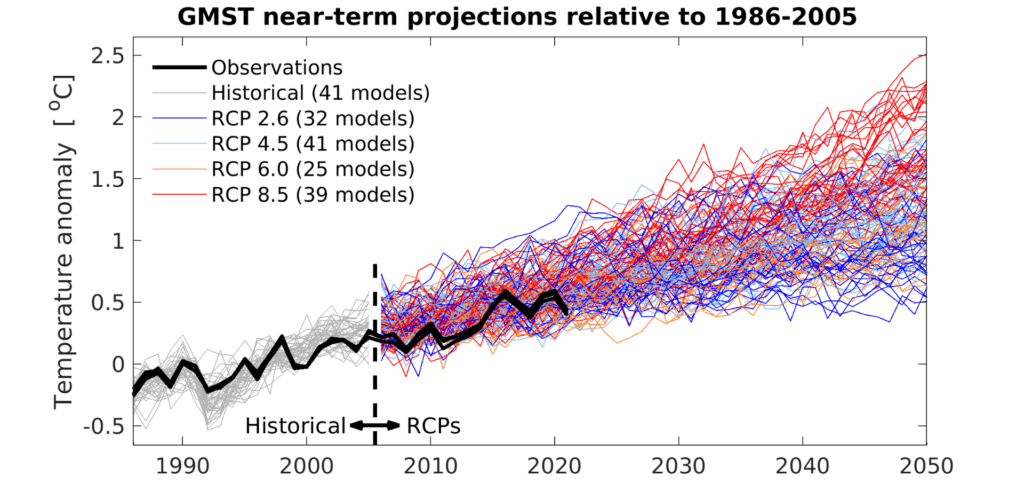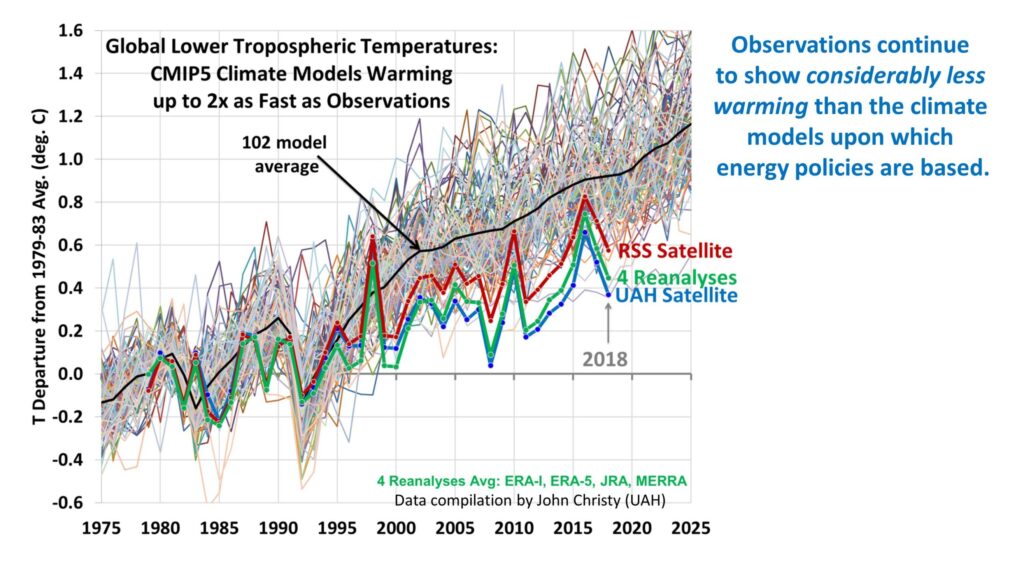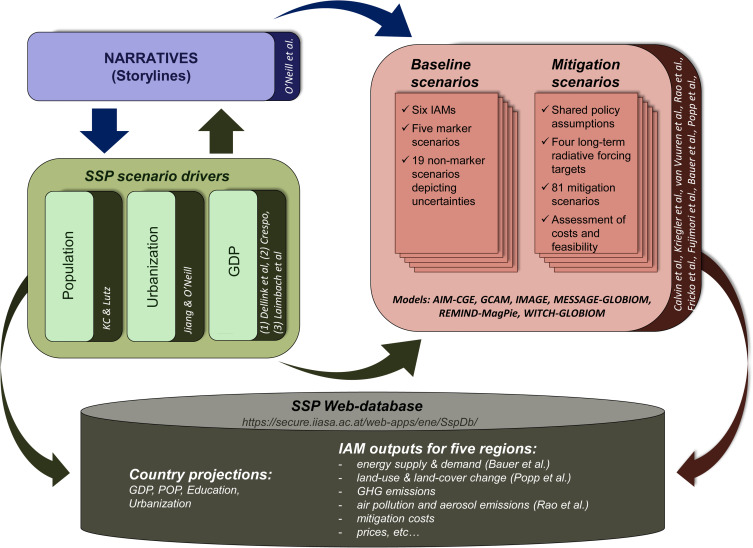- Climate models show very little agreement between themselves and with reality
- Attempts to simulate complex interactions within the natural world and between the environment and society are very often misleading
- The use of models in environmental politics has a long history of failure and ideological motivation which is omitted from public discussion about climate change
Climate models are computer simulations of the natural world. Scientists involved in creating these simulations believe that mathematical descriptions of the natural processes involved in climate can aid in the understanding of how global warming will develop in the future. However, attempts to simulate the climate in the past have produced significantly divergent results, which often do not compare well to reality. Modellers have defended their work, but the field remains an extremely contested field, beset by controversy.
Divergence
The problem at the centre of the controversy is that models disagree with each other and largely disagree with observations. This is shown in the following graphic produced by UK climate scientist, Ed Hawkins at the University of Reading. The ‘spaghetti’ of data series labelled as ‘RCP X.X’, refer to models’ outputs, whose inputs are based on different assumptions about how policy will affect future CO2 emissions. Observations of global temperature tend towards the lower end of the range of predictions made by computer simulations. This would suggest that the atmosphere is much less sensitive to CO2 than the models, and therefore climate science in general, tends to assume.

Other climate scientists have produced analyses, which when compared with satellite data, produce an even more radical disagreement between models and observations.

And here is a third analysis produced by independent scientist, Clive Best, showing model projections out to 2100, where there is clearer distinction between the models’ outputs, from different RCP scenarios, which are compared with the now superseded HADCRUT4.6 observational record.

Climate scientist, Judith Curry, suggests that the IPCC, in its most recent Assessment Report, has begun to acknowledge the problem, arguing that models are of diminishing value to the scientific understanding of climate change. Other reports, from within the consensus position, are also acknowledging that climate models are too warm, and that there is more time to prevent climate change than has previously been stated. It is important to note that these claims are categorically not from the climate sceptic camp.
Is climate modelling even possible?
Some views are more damning of climate models as a science at all. According to mathematician, Dr Christopher Essex of the University of Western Ontario, many basic problems of computation prevent computers producing faithful representations of the climate. Put simply, from a computational perspective, the world is effectively infinitely complex, whereas even the most advanced supercomputers have to treat large parts of the world as a single unit. For example, the modelled counterparts of the atmosphere and ocean in a computer simulation are composed of blocks 1 km on each side. Attempts to overcome this problem of resolution require techniques that attempt to parameterise phenomena which are impossible for a computer to simulate at scale, but which may introduce significant errors. According to Essex, these errors are fatal:
The empirical nature of large climate models can be clearly seen in their diverse outputs. If they followed the laws of physics in their entirety, they would all produce the same results under the same conditions. But they do not. In a recent study, the Climate Model Inter-comparison Project phase 3 (CMIP3) models […] were considered and a detailed comparison at the dynamics level, using an approach involving climate networks [..] was performed. It was found that the models not only don’t agree with each other when it comes to dynamics, they also don’t agree with reality
Stacking models on models
As well as being used to attempt to predict global warming and its first-order effects (including climate feedbacks), computer models have been used to attempt to mode more complex interactions within the natural environment itself, and between the environment and society. Some researchers believe that the relationship between global warming and social effects such as poverty and war can be understood using models. Many people, including scientists attached to the mainstream or consensus view of the broader debate, believe that this expects far too much of computer modelling. Some also believe that at regional scales, modelling has very low skill at making useful projections. However, models have been used to develop political narratives, principally to create storylines about what climate change will look like in the future.
In the map of our Guide to the climate debate, we show that the claims made in the debate divide into five categories, and that it is largely modelling that joins the gaps between these categories: between global warming and climate change, climate change and climate impacts, climate impacts and climate crisis, and so on.

Considerable uncertainty exists about how global warming will develop, and what the implications are for climate change, climate impacts, and the effects on society (climate crisis). Researchers use models to try to understand the relationship between, for example, the temperature of the planet and the incidence of meteorological drought in a particular place. Or an understanding of how much global warming will increase rainfall (precipitation) events may help to inform a simulation that is intended to show how much flooding of inland areas is likely to occur. Finally, output from such a model may then go on to inform attempts to model (simulate) the relationship between flooding and poverty, also using economic and historical data as inputs.
Though this may seem sensible, one major problem is that modelling exercises that are logically downstream of global warming may take extreme warming modelling scenarios as their input, to predict impacts such as species extinction and biodiversity loss, which are equally extreme. Assumptions can cascade through such chains of reasoning, multiplying errors. Simulations of global warming are controversial enough, and adding complexity by plugging a model of global warming into attempts to simulate Nth-order consequences can only increase the uncertainty of such projections, with decreasing value to science, albeit with increasing value to political messaging.
This cascading and multiplication of error is not hypothetical. It can be observed in practice. Some researchers have pointed out that much work that features in the IPCC’s assessment of climate change research begins from implausible future emissions scenarios. Known as Representative Concentration Pathways (RCPs), and more recently as Shared Socioeconomic Pathways (SSPs), various scenarios are groups of assumptions about the drivers and policy response to climate change. Some scenarios assume no policy intervention and for society to significantly increase CO2 emissions. Other scenarios assume a strict reduction in emissions, through to net zero towards the middle of the century.

Source: https://www.sciencedirect.com/science/article/pii/S0959378016300681
These scenarios include many political and contestable assumptions, and are used in simulations to estimate the future, in terms of both changes to the climate and consequences of warming, to evaluate policy. Critical (and necessarily sceptical) researchers observed a very significant bias towards the most extreme of these scenarios, and the fact that this bias creates dramatic headlines, but it misleads the broader understanding of climate change and the debate about policy.
A history of failed projections
The first applications of computer modelling in the field of environmental politics were used to make dire predictions about the imminent collapse of civilisation. The most influential of these was the Limits to Growth (LtG) hypothesis published by the global think tank, the Club of Rome in 1972. The predictions were made well before fears about global warming, but scientists and the founders of the organisation believed that their models proved that population growth, resource depletion and pollution would soon overwhelm the Earth’s capacity to support life.
The Club of Rome’s predictions were simply wrong. The world’s population grew, but so did its wealth. As it pointed out in our articles in the climate crisis category, the world experienced a historically unprecedented improvement in its condition according to all metrics of human welfare during the era that the Club of Rome’s computer simulation predicted would see the collapse of civilisation.
Nonetheless, computer modelling has continued to be at the centre of global environmental politics, with very little attention paid to its historic failures, and its tendency to produce extremely alarming predictions. What this history demonstrates is that modelling of this kind has very little use in science, but, by lending scientific authority to extremely dramatic storylines, it has immense political utility. A thorough debate about climate change, from science to policy, is needed to explore the role of ideology in computer modelling.
Further reading
Climate models for the layman. Judith Curry. The GWPF.
What Is A Model? We need to know to test between good and bad science
